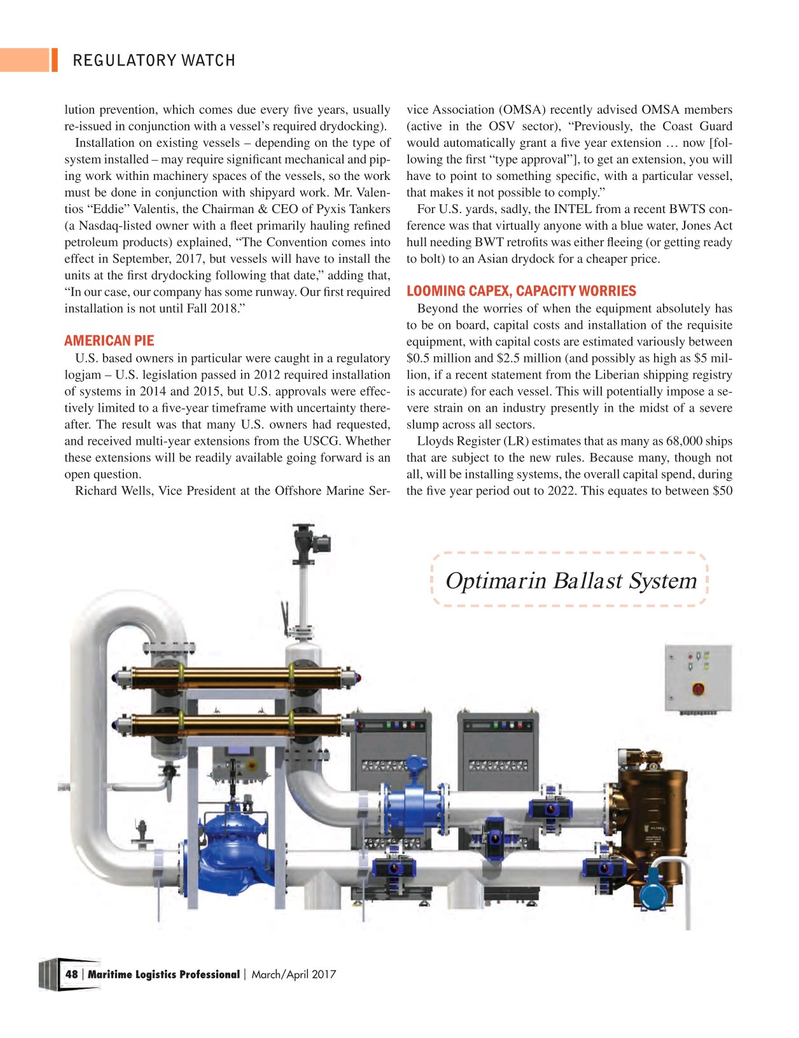
Page 48: of Maritime Logistics Professional Magazine (Mar/Apr 2017)
IT & SOFTWARE
Read this page in Pdf, Flash or Html5 edition of Mar/Apr 2017 Maritime Logistics Professional Magazine
REGULATORY WATCH lution prevention, which comes due every ? ve years, usually vice Association (OMSA) recently advised OMSA members re-issued in conjunction with a vessel’s required drydocking). (active in the OSV sector), “Previously, the Coast Guard
Installation on existing vessels – depending on the type of would automatically grant a ? ve year extension … now [fol- system installed – may require signi? cant mechanical and pip- lowing the ? rst “type approval”], to get an extension, you will ing work within machinery spaces of the vessels, so the work have to point to something speci? c, with a particular vessel, must be done in conjunction with shipyard work. Mr. Valen- that makes it not possible to comply.” tios “Eddie” Valentis, the Chairman & CEO of Pyxis Tankers For U.S. yards, sadly, the INTEL from a recent BWTS con- (a Nasdaq-listed owner with a ? eet primarily hauling re? ned ference was that virtually anyone with a blue water, Jones Act petroleum products) explained, “The Convention comes into hull needing BWT retro? ts was either ? eeing (or getting ready effect in September, 2017, but vessels will have to install the to bolt) to an Asian drydock for a cheaper price. units at the ? rst drydocking following that date,” adding that, “In our case, our company has some runway. Our ? rst required LOOMING CAPEX, CAPACITY WORRIES installation is not until Fall 2018.” Beyond the worries of when the equipment absolutely has to be on board, capital costs and installation of the requisite
AMERICAN PIE equipment, with capital costs are estimated variously between
U.S. based owners in particular were caught in a regulatory $0.5 million and $2.5 million (and possibly as high as $5 mil- logjam – U.S. legislation passed in 2012 required installation lion, if a recent statement from the Liberian shipping registry of systems in 2014 and 2015, but U.S. approvals were effec- is accurate) for each vessel. This will potentially impose a se- tively limited to a ? ve-year timeframe with uncertainty there- vere strain on an industry presently in the midst of a severe after. The result was that many U.S. owners had requested, slump across all sectors.
and received multi-year extensions from the USCG. Whether Lloyds Register (LR) estimates that as many as 68,000 ships these extensions will be readily available going forward is an that are subject to the new rules. Because many, though not open question. all, will be installing systems, the overall capital spend, during
Richard Wells, Vice President at the Offshore Marine Ser- the ? ve year period out to 2022. This equates to between $50
Optimarin Ballast System 48 Maritime Logistics Professional March/April 2017 | |

 47
47

 49
49
